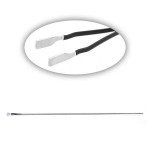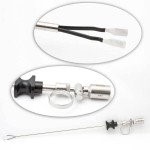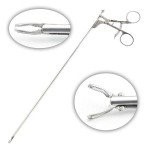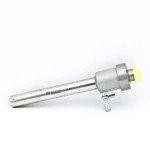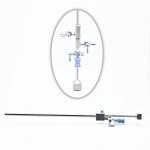
Laparoscopic Gynecology Surgical Instrument
Laparoscopic Gynecology Surgical Instrument: The Cutting-Edge Tools
Table of contents
• Introduction
• Laparoscopic Surgical Instruments
• The Advantages of laparoscopic gynecology surgery
• Preparation for laparoscopic gynecology surgery
• The laparoscopic gynecology surgical procedure
• Postoperative care and recovery
• Conclusion
Introduction
So you're curious about laparoscopic gynecology surgery? Well, you've come to the right place! Laparoscopic surgery is a minimally invasive technique that has revolutionized the way gynecological procedures are performed. Essentially, laparoscopic gynecology surgery involves making small incisions in the abdomen and inserting a tiny camera and specialized instruments to perform the surgery. This technique offers numerous advantages over traditional surgery, including minimal scarring, a lower risk of infection, faster recovery times, and less postoperative pain. While it may seem like a relatively new technique, laparoscopic surgery has actually been around since the early 1900s. However, it wasn't until the 1980s that it gained popularity as an alternative to traditional surgery. Since then, laparoscopic surgery has become the preferred method for many gynecological procedures. If you're considering laparoscopic gynecology surgery, it's important to prepare properly. Your doctor will likely perform a physical evaluation and order some lab tests to ensure you are healthy enough to undergo the surgery. They will also provide you with instructions for the day of the surgery. Overall, laparoscopic gynecological surgery is a safe and effective option for many gynecological procedures. Not only does it offer numerous advantages over traditional surgery, but it also allows for a faster recovery time and less postoperative pain. So why not take advantage of modern medical technology and make your next procedure a laparoscopic one?
Laparoscopic Surgical Instruments
Laparoscopic gynecology surgery has revolutionized the way surgical procedures are conducted. The use of laparoscopic surgical instruments has made it possible to perform delicate surgeries with minimal incisions, which ultimately results in less postoperative pain, reduced risk of infection, and faster recovery time. There are various types of laparoscopic instruments that are used in gynecology surgery, including graspers, scissors, needle holders, and electrosurgical instruments. These instruments are inserted into the abdomen through small incisions and are controlled by the surgeon through a video monitor. The components of laparoscopic instruments include a handle, a shaft, and a tip. The handle is held by the surgeon and controls the movement of the tip, which is the part that actually performs the surgical task. The shaft connects the handle to the tip and is responsible for transmitting the surgeon's movements. Some specific instruments that are used in laparoscopic gynecology surgery include the laparoscope, which is a camera that provides the surgeon with a visual image of the pelvic organs, and the uterine manipulator, which is used to move the uterus during surgery. Other instruments include the tissue morcellator, which breaks up and removes tissue, and the bipolar energy instruments, which use heat to seal blood vessels and minimize bleeding. In summary, laparoscopic surgical instruments have revolutionized the field of gynecology surgery. Their use has led to faster recovery times, less postoperative pain, and fewer complications. These instruments provide a less invasive alternative to traditional surgery and allow surgeons to perform delicate procedures with minimal incisions.
The Advantages of laparoscopic gynecology surgery
Let's face it, surgery is scary. The thought of going under the knife alone is enough to make anyone nervous. But what if there was a way to make the surgery less intimidating? Enter laparoscopic gynecology surgery. This modern method of surgery has several advantages over traditional surgery. For one, the incisions made during laparoscopic surgery are much smaller, resulting in minimal scarring. It also reduces the risk of infection, which is a major concern for anyone who has ever had surgery. But perhaps the biggest advantage is the faster recovery time. Who wants to spend weeks or even months recovering from surgery when they could be out and about living their life? With laparoscopic gynecology surgery, patients can return to their daily activities much sooner than with traditional surgery. Plus, since there is less postoperative pain, there will be less need for pain medication. So, if you're in need of gynecologic surgery, consider asking your doctor about laparoscopic surgery. You'll experience less scarring, less risk of infection, and a quicker recovery time. Who wouldn't want that?
Preparation for laparoscopic gynecology surgery
Preparation for laparoscopic gynecology surgery is essential to ensure a successful procedure. The first step is a physical evaluation to assess the patient's overall health and to identify any potential risks or complications. Next, lab tests are conducted to get a better understanding of the patient's health status. On the day of the surgery, the patient will receive instructions on how to prepare for the procedure, including what to eat and drink, what medications to avoid, and when to arrive for the surgery. It's critical to follow these instructions carefully to ensure that the surgery goes smoothly. Remember, an ounce of prevention is worth a pound of cure!
The laparoscopic gynecology surgical procedure
So, you've made it to the main event - the actual surgical procedure. Don't worry, you're in good hands. The first step will involve administering anesthesia and getting you into the appropriate position. They'll make sure you're comfortable and ready to go. Next up, it's time to get those tools in there. The laparoscope, a long, thin tube with a camera attached to the end, will be inserted into your body through a small incision (remember those advantages of minimal scarring?). This will provide your surgeon with a clear view of your internal organs and allow them to guide the other instruments. Speaking of instruments, there are a variety of tools that may be used depending on the specifics of your procedure. These could include forceps, scissors, and electrocautery devices. Again, don't worry - your surgeon is highly trained and experienced in using these tools safely and effectively. Once everything is in place, it's time to get to work. Your surgeon will use the instruments to perform the necessary surgical tasks. Depending on the procedure, this could involve removing tissue or tumors, repairing damage, or simply exploring the area in question. Once everything is complete, the instruments will be removed, and the incisions will be closed up. You'll be taken to a recovery room to start the healing process. See, that wasn't so bad, was it?
Postoperative care and recovery
So, you have successfully undergone laparoscopic gynecology surgery, and now it's time for postoperative care and recovery. Firstly, let's talk about the hospital stay duration. Generally, patients are discharged after a day or two, but it may vary depending on the complexity of the surgery and the individual's recovery progress. Now, let's focus on self-care tips for at-home recovery. It's crucial to take proper rest and refrain from any strenuous activities. Also, make sure to keep the surgical site clean and dry to prevent infection. You may experience some discomfort and bloating, but it's temporary, and with time, it will subside. Lastly, let's discuss possible complications and how to prevent them. Although laparoscopic surgery is considered safe, there may be rare instances where complications like bleeding, infection, or injuries to organs may occur. It's vital to follow the doctor's instructions and attend follow-up appointments to prevent any such complications. Overall, postoperative care and recovery play a crucial role in the success of laparoscopic gynecology surgery. So, do listen to your body, follow the guidelines given by the doctor, and soon you will be up on your feet again.
Conclusion
In summary, laparoscopic gynecology surgery is a game-changer. Its cutting-edge surgical instruments offer minimal scarring, lower risk of infection, and faster recovery time. For successful surgery, proper preparation and postoperative care are crucial. With the aid of laparoscopic surgical instruments, gynecological surgeries are now more efficient and safe.
CLASSIC HASSON CANNULA, 11mm COMPLETE

